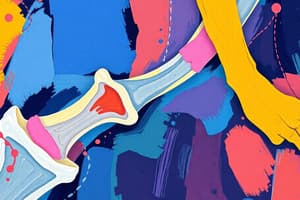Podcast
Questions and Answers
What should the nurse monitor in a patient during the oliguric phase of AKI?
What should the nurse monitor in a patient during the oliguric phase of AKI?
- ECG changes (correct)
- Hemoglobin levels
- Fluid intake
- Weight loss
Which fluid replacement is typically given to patients with a fluid volume deficit?
Which fluid replacement is typically given to patients with a fluid volume deficit?
- Colloids
- Normal saline
- Lactated ringer solution (LR) (correct)
- D5W
What dietary change can be expected for a patient on hemodialysis after years of chronic CKD?
What dietary change can be expected for a patient on hemodialysis after years of chronic CKD?
- Increased fat intake
- More protein (correct)
- Lower sodium
- Reduced carbohydrates
Which assessment should be reported when a client on IV diuretics shows a potassium level below 3.5?
Which assessment should be reported when a client on IV diuretics shows a potassium level below 3.5?
Which lab value should be monitored to determine the effectiveness of calcium carbonate in a patient with CKD?
Which lab value should be monitored to determine the effectiveness of calcium carbonate in a patient with CKD?
What is a key priority action for a patient with a potassium level of 7.0?
What is a key priority action for a patient with a potassium level of 7.0?
Which habit should a nurse advise to avoid in clients who struggle with sleep?
Which habit should a nurse advise to avoid in clients who struggle with sleep?
What symptom should the nurse expect to assess in a client deprived of sleep?
What symptom should the nurse expect to assess in a client deprived of sleep?
Which assessment finding is most indicative of a patient developing compartment syndrome?
Which assessment finding is most indicative of a patient developing compartment syndrome?
Before administering sodium polysystene (Kayexalate) to a patient with hyperkalemia, what should the nurse assess?
Before administering sodium polysystene (Kayexalate) to a patient with hyperkalemia, what should the nurse assess?
What should the nurse inquire about when a patient in the first trimester of pregnancy expresses concerns about frequent urination?
What should the nurse inquire about when a patient in the first trimester of pregnancy expresses concerns about frequent urination?
To prevent the recurrence of uric acid kidney stones, what dietary item should the patient avoid?
To prevent the recurrence of uric acid kidney stones, what dietary item should the patient avoid?
For a patient diagnosed with excess fluid volume, what sign or symptom should the nurse monitor?
For a patient diagnosed with excess fluid volume, what sign or symptom should the nurse monitor?
What inference can the nurse make regarding a patient with CKD who has a hemoglobin level of 8.0?
What inference can the nurse make regarding a patient with CKD who has a hemoglobin level of 8.0?
What is an important nursing intervention to reduce the risk of deep vein thrombosis (DVT) postoperatively?
What is an important nursing intervention to reduce the risk of deep vein thrombosis (DVT) postoperatively?
Which symptom should the nurse prioritize reporting to the surgeon during the preoperative assessment?
Which symptom should the nurse prioritize reporting to the surgeon during the preoperative assessment?
What manifestations should the nurse be alert for in a patient receiving loop diuretics?
What manifestations should the nurse be alert for in a patient receiving loop diuretics?
When a patient with AKI and hypokalemia asks why IV insulin is being prescribed, what should the nurse explain?
When a patient with AKI and hypokalemia asks why IV insulin is being prescribed, what should the nurse explain?
What dietary recommendation is important for a patient experiencing a flare of Crohn's disease?
What dietary recommendation is important for a patient experiencing a flare of Crohn's disease?
When is it appropriate to send a preoperative patient to surgery without consulting the surgeon about their questions?
When is it appropriate to send a preoperative patient to surgery without consulting the surgeon about their questions?
Which priority assessment should a nurse perform first for a patient who has just vomited bright red blood?
Which priority assessment should a nurse perform first for a patient who has just vomited bright red blood?
Which type of fracture is most commonly associated with child abuse?
Which type of fracture is most commonly associated with child abuse?
What is a common complication following orthopedic surgeries that should be monitored closely?
What is a common complication following orthopedic surgeries that should be monitored closely?
Which factor can significantly impact wound healing in patients?
Which factor can significantly impact wound healing in patients?
What dietary concern should be considered for a patient receiving parenteral nutrition?
What dietary concern should be considered for a patient receiving parenteral nutrition?
Which medication class is commonly used in the treatment of GERD?
Which medication class is commonly used in the treatment of GERD?
What is a key sign of sleep deprivation?
What is a key sign of sleep deprivation?
What condition is characterized by the abnormal accumulation of uric acid in the blood?
What condition is characterized by the abnormal accumulation of uric acid in the blood?
Which type of IV fluid can lead to hypernatremia if administered inappropriately?
Which type of IV fluid can lead to hypernatremia if administered inappropriately?
Which of the following is a common clinical manifestation of acute kidney injury (AKI)?
Which of the following is a common clinical manifestation of acute kidney injury (AKI)?
What is a primary nursing intervention to manage a patient with compartment syndrome?
What is a primary nursing intervention to manage a patient with compartment syndrome?
Flashcards
Spiral Fracture
Spiral Fracture
A fracture in which the bone breaks in a twisting motion.
Greenstick Fracture
Greenstick Fracture
A fracture in which the bone bends and cracks, but does not completely break. Commonly seen in children.
Comminuted Fracture
Comminuted Fracture
A fracture in which the bone is broken into many pieces.
Osteoporosis
Osteoporosis
Signup and view all the flashcards
Osteomyelitis
Osteomyelitis
Signup and view all the flashcards
Compartment Syndrome
Compartment Syndrome
Signup and view all the flashcards
DVT
DVT
Signup and view all the flashcards
Sleep Apnea
Sleep Apnea
Signup and view all the flashcards
Sleep Deprivation
Sleep Deprivation
Signup and view all the flashcards
Refeeding Syndrome
Refeeding Syndrome
Signup and view all the flashcards
Compartment Syndrome Assessment
Compartment Syndrome Assessment
Signup and view all the flashcards
Hyperkalemia Medication Assessment
Hyperkalemia Medication Assessment
Signup and view all the flashcards
Frequent Urination in Pregnancy
Frequent Urination in Pregnancy
Signup and view all the flashcards
Uric Acid Kidney Stones Prevention
Uric Acid Kidney Stones Prevention
Signup and view all the flashcards
Excess Fluid Volume Signs
Excess Fluid Volume Signs
Signup and view all the flashcards
CKD Hemoglobin 8.0
CKD Hemoglobin 8.0
Signup and view all the flashcards
Loop Diuretic Manifestations
Loop Diuretic Manifestations
Signup and view all the flashcards
AKI Hypokalemia Insulin
AKI Hypokalemia Insulin
Signup and view all the flashcards
Hypocalcemia Prevention
Hypocalcemia Prevention
Signup and view all the flashcards
Insulin and Potassium
Insulin and Potassium
Signup and view all the flashcards
Oliguric Phase of AKI
Oliguric Phase of AKI
Signup and view all the flashcards
Fluid Replacement for Volume Deficit
Fluid Replacement for Volume Deficit
Signup and view all the flashcards
Dietary Changes with Hemodialysis
Dietary Changes with Hemodialysis
Signup and view all the flashcards
Hypokalemia and Diuretics
Hypokalemia and Diuretics
Signup and view all the flashcards
Calcium Carbonate and Phosphate
Calcium Carbonate and Phosphate
Signup and view all the flashcards
High Potassium Level in AKD
High Potassium Level in AKD
Signup and view all the flashcards
Pre-op Smoking
Pre-op Smoking
Signup and view all the flashcards
Pre-op Patient Questions
Pre-op Patient Questions
Signup and view all the flashcards
Managing Post-op DVT
Managing Post-op DVT
Signup and view all the flashcards
Post-op Pain Management
Post-op Pain Management
Signup and view all the flashcards
Gastroesophageal Reflux Disease (GERD)
Gastroesophageal Reflux Disease (GERD)
Signup and view all the flashcards
Study Notes
Bone Disorders (14 Questions)
- Types of fractures (matching): Transverse, Linear, Oblique, Spiral, Greenstick, Comminuted, Nondisplaced, Displaced
- Spiral fractures: Often associated with child abuse
- Greenstick fractures: Common in children, caused by bending force (e.g., football player getting hit)
- Comminuted fractures: Bone is fragmented into multiple pieces
- Osteoporosis
- Osteomyelitis
- Gout
Application Level Questions (Bone Disorders)
- Compartment Syndrome
- Osteomyelitis
- Rhabdomyolysis
- Deep Vein Thrombosis (DVT)
- Case Study: Post-op ORIF patient with one-sided lower extremity pain and redness (10 points)
- Identify the complication (1 point)
- List 3 nursing interventions prior to contacting provider (3 points)
- Write a SBAR report (6 points)
Perioperative Care (5 Questions)
- Patient education (pre-op, post-op, discharge instructions)
- Smoking cessation strategies
- Prevention and management of post-op complications (pneumonia, DVTs)
- IV and oral pain management meds (choosing appropriate ones based on patient symptoms)
- Informed consent: When to send a patient to surgery vs. having a surgeon visit pre-operatively.
Sleep (6 Questions)
- Sleep apnea: Signs and symptoms, CPAP and non-CPAP treatments.
- Sleep deprivation: Signs and symptoms
- Sleep hygiene: Best practices for improving sleep.
- Factors impairing sleep.
- BONUS question: HR changes in age/fitness levels.
Nutrition (4 Questions)
- Nursing considerations for parenteral and enteral feedings
- Patient safety related to Parenteral and enteral feedings
- PPN vs. TPN vs. tube feeds
- Lab values, diagnostic studies (fasting glucose, vital signs)
- Metabolic Syndrome
- Labs associated with nutritional status (e.g., low albumin)
- Refeeding syndrome
Skin (4 Questions)
- Sunscreen guidance and recommendations
Fluid & Electrolytes (6 Questions)
- Difference between hypo/hyper/isotonic fluids
- Types of IV Fluids
- Clinical manifestations and causes of hypo/hyperkalemia (use Electrolyte Quick Reference Guide)
- Treatment for hyperkalemia
- Causes of Fluid Deficit and/or Excess (use Fluid Imbalance Study Guide)
Renal (5 Questions)
- Labs linked to kidney function
- Causes of Acute Kidney Injury (AKI)
- Clinical manifestations of each phase of AKI
- Stages of Chronic Kidney Disease (CKD)
- Causes of uric acid kidney stones
- Medication for Chronic Kidney Disease (outlined in PowerPoint)
- Contraindications for medications
- Assessment data prior to medication administration
GU (2 Questions)
- Incontinence (types, treatment options)
- Nursing considerations for incontinence (select-all-that-apply)
GI (10 Questions)
- Lower vs Upper GI bleeds (assessment, fluid volume deficit, priority intervention)
- Crohn's disease, Ulcerative Colitis
- Fistulas
- GI bleed
- GERD medications (H2 blockers and PPIs)
- Peritonitis: Treatment (priority)
- Peptic ulcer disease: Medications to avoid; Risk factors/causes.
- Case Study: Abdominal pain (10 points)
- Identify suspected GI problem
- Identify elevated lab value (if any)
- List diagnostic studies for possible cause of pain
- Describe predicted intervention/treatments
- Describe anticipated consequences if untreated
Studying That Suits You
Use AI to generate personalized quizzes and flashcards to suit your learning preferences.




